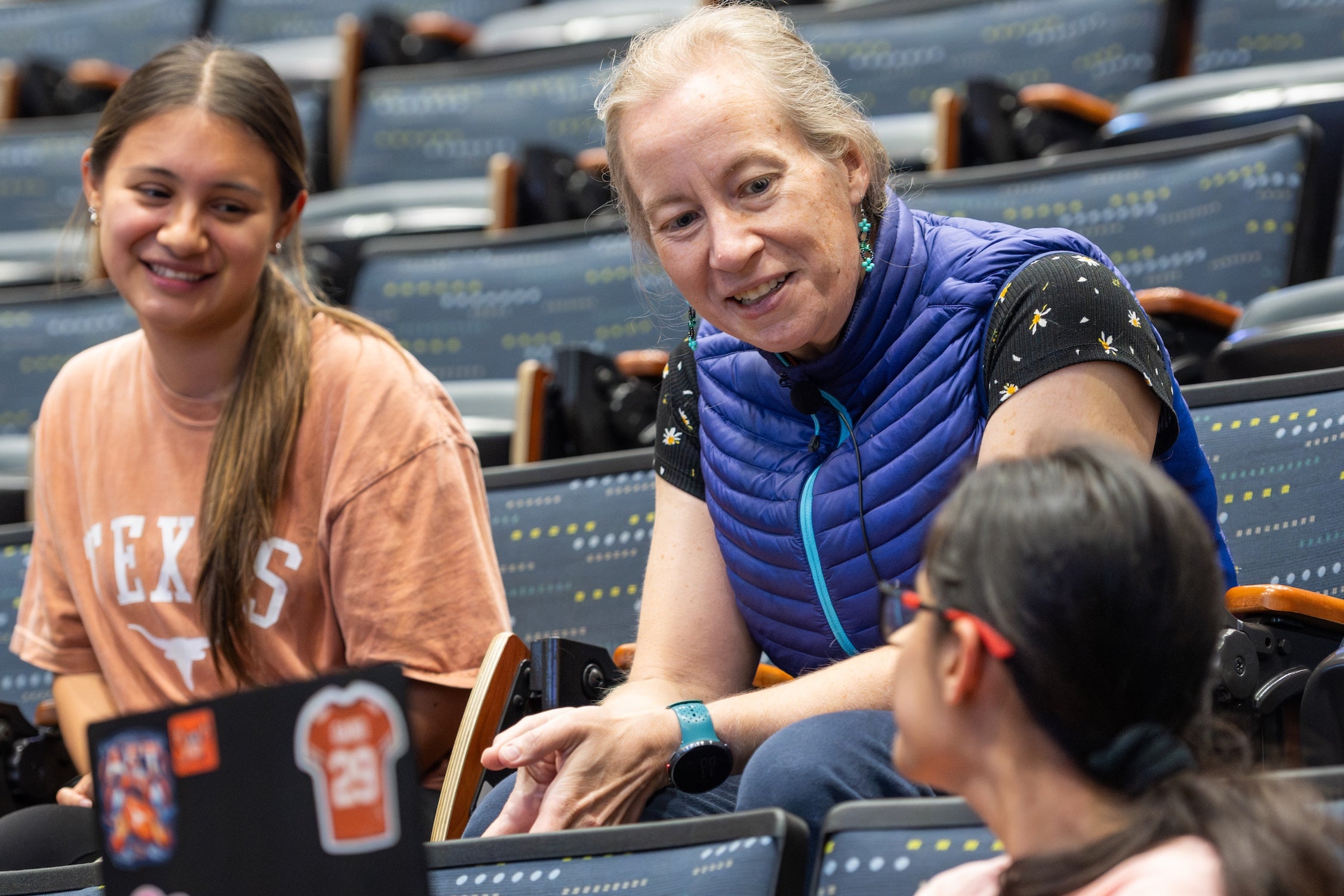Remembering Steven Weinberg
Steven Weinberg was best known for his Nobel-prize winning work that unified two fundamental forces of nature — electromagnetism and the weak force.

Today, in the first of two parts of a special segment, we're remembering the life and legacy of one of the greatest theoretical physicists of all time — The University of Texas at Austin's Steven Weinberg, who died in July. We're exploring who he was as a scientist, writer and mentor — and a deep thinker about our place in the universe. We'll hear from colleagues who worked with him — fellow UT Austin physicists Katherine Freese, Willy Fischler and Can Kilic — and from his former student John Preskill.
What They're Saying
After his passing, tributes to Weinberg began to flood social media, news sites and public events. Here are a few from other current and former UT Austin scientists:
"Before his untimely death in July at age 88, Steven Weinberg was widely regarded as the greatest living physicist. He was certainly a living legend. As a Texan for 40 of those years, he was our living legend, too, and our claim to a piece of physics history, productive to the end, as a theoretical physicist, cosmologist, historian of science, teacher, mentor, author, communicator and the deepest of thinkers about the deepest of questions. From the moment he arrived in Austin in 1981, dust hardly settled on his newly-minted Nobel prize, to the last weeks of his life, Steve continued to create and produce and influence the progress of fundamental physics—and of Texas physics, too – including astronomy." (read the full remarks) - Paul Shapiro, Frank N. Edmonds, Jr Regents Professor in Astronomy, UT Austin (colleague of Weinberg's for more than 40 years and one of the rare few who wrote a coauthored paper with him)
"Steve is one of the very few people in my life who have seemed other-worldly and larger than life, even after I got to know him. I'll miss him both as a person and a scientist." - Mike Boylan-Kolchin, associate professor of astronomy, UT Austin
"When he taught a class, he usually wrote a textbook based on his notes, and he was proud of the fact that he wrote everything himself, including all the equations in LaTeX." - Mark Raizen, professor of physics and of medicine, UT Austin
"The impact of Steve's long and productive career on theoretical physics can hardly be overstated. While most would count themselves lucky to have one important result named after them, there are many that carry Steve's name: Weinberg's soft graviton theorem, the Weinberg sum rules, the Weinberg operator, the Weinberg angle (which I have always heard him refer to as the weak mixing angle), the Weinberg–Witten theorem, the Lee–Weinberg bound, and so on." - Raphael Flauger, associate professor of physics, University of California, San Diego (formerly assistant professor at UT Austin and former student of Steven Weinberg)
Scott Aaronson noted that Weinberg once famously wrote "The more the universe seems comprehensible, the more it also seems pointless." But, Aaronson said, this did not mean Weinberg didn't find meaning and purpose in living.
"Steve never for a nanosecond acted as if life was pointless. He already had all the material comforts and academic renown anyone could possibly want. He could have spent all day in his swimming pool or listening to operas. Instead, he continued publishing textbooks—a quantum mechanics textbook in 2012, an astrophysics textbook in 2019, and a "Foundations of Modern Physics" textbook in 2021 (!). As recently as this year [2021], he continued writing papers—and not just "great man reminiscing" papers, but hardcore technical papers. He continued writing with nearly unmatched lucidity for a general audience, in the New York Review of Books and elsewhere. And I can attest that he continued peppering visiting speakers with questions about stellar evolution or whatever else they were experts on—because, more likely than not, he had redone some calculation himself and gotten a subtly different result from what was in the textbooks." - Scott Aaronson, professor of computer science at the University of Texas at Austin
Show Notes
Donate to the Physics Theory Group, in memory of Steven Weinberg
In addition to original interviews, today's episode features excerpts from two videos:
On the Shoulders of Giants: Steven Weinberg and the Quest to Explain the World (2021), World Science Festival
Interview with Professor Steven Weinberg (2001), Nobel Prize Committee
Our theme music was composed by Charlie Harper
Other music for today's show was produced by: Podington Bear
TRANSCRIPT
Katherine Freese: As I told Steve — I was hesitant to do it, but I finally did say — you know, of all the physicists in the world, you need to know that I think of you as the most brilliant living physicist. And it was hard for me to say it to him, but he liked that, obviously.
Willy Fischler: Steve has made so many contributions to theoretical physics that he's definitely a historical figure. History books of science will remember him.
Can Kilic: Not a lot of fields have something that is called the Standard Model. … you do something and the entire field takes that as sort of the foundation to build upon.
Marc Airhart: This is Point of Discovery. I'm Marc Airhart. Today, in the first of two parts of a special segment, we're remembering the life and legacy of one of the greatest theoretical physicists of all time — The University of Texas at Austin's Steven Weinberg, who died in July. He's best known for his Nobel-prize winning work that unified two fundamental forces of nature — electromagnetism and the weak force. They became a central pillar of something called the Standard Model of Particle Physics. In part 2, we'll take a deep dive into the Standard Model and Weinberg's attempts to go beyond it — to something simpler and more beautiful. Today, we're exploring who he was as a scientist, writer, mentor — and a deep thinker about our place in the universe. We'll hear from colleagues who worked with him — fellow UT Austin physicists Katherine Freese, Willy Fischler and Can Kilic — and from his former student John Preskill.
MA: Katherine Freese is a member of the National Academy of Sciences and a world-renowned cosmologist. But back in graduate school, she was supposed to be doing particle accelerator experiments at FermiLab near Chicago. At the time, she was living in a farmhouse with other student experimentalists.
KF: And there are buffalo roaming around and this and that ...
MA: But she wanted to spend more time in the city, so she would sneak off to audit a cosmology class at the University of Chicago.
KF: The very beginning of the class, it wasn't assumed that you knew relativity, but it sure would have been helpful. And I had never learned it before. So the textbook recommended was Steven Weinberg's Gravitation and Cosmology. And so I became a very, very bad experimental student, because I started staying in the farmhouse and I read through that book, I devoured it ... And it just really blew me away. I mean, I started abandoning the work I was supposed to do.
MA: She transferred to the University of Chicago. She credits that textbook — and by extension, Steve Weinberg himself — with inspiring her to become a cosmologist.
KF: Nobody explained things better than Steve Weinberg did — nobody. He was absolutely crystal clear, logical, all the pieces were there. He had a brilliant mind and it seemed like an infinite memory. So he had all the pieces there. And he wrote them all down for you, you know, so it was a very clear introduction. And the perspective was really interesting and exciting.
MA: Weinberg wrote textbooks for his fellow scientists, but he also wrote books and essays for the rest of us, including his extremely popular book The First Three Minutes, about the birth of our universe. His former student John Preskill, himself a highly successful physicist, was recently interviewed in a documentary by the producers of the World Science Festival.
John Preskill: Particularly in his later career, he was a marvelously effective scientific communicator. … Any subject that caught his interest he could write about with exceptional clarity and with real intellectual honesty. You know, he would tell you exactly what he thought and he would explain to you why. And he did that with great respect for the reader. I think this was an important thing to realize about Steve as a communicator. He appreciated that there are people who are not scientifically trained but are just as smart as … people who do have some training in theoretical physics. He didn't talk down to them. But of course he realized you couldn't talk to them in jargon. So he had a very strong gift for communicating things through clear language and good examples and analogies.
MA: The scientists I interviewed described many contributions Weinberg made — even beyond the work on unifying forces of nature and the Standard Model. They mentioned the development of Effective Field Theories, which — well, let's just say it gets complicated pretty fast. But the point is that he accomplished more, and had a bigger impact on his field, than most scientists are able to do in one lifetime. So I wondered, what was his secret? Willy Fischler, an award-winning theoretical physicist himself and a member of the Weinberg group, summarized it this way:
WF: What was remarkable about Steve is when he decided, "This is a problem I want to understand," he would not leave any stone unturned until he understood all the aspects of the problem. The way he operated, his modus operandi in physics was this unlikely blend of a perfectly choreographed ballet and the unstoppable advance of a column of Russian tanks. I mean he—you couldn't stop him. I mean he would not stop until he understood what was going on in the problem.
MA: Can Kilic, an associate professor of physics, agrees:
CK: To me, it seemed like part of the special sauce was his ability to really take a fresh look at a problem that, even a problem that had been there for a while, but he could step back, not get, you know, limited, fenced in by people's previous ideas about this. And just look at it fully rationally, identify sort of the core issue and 'Ah, I have an idea that I don't think people have had before.'
WF: Basically, Steve had I would say two loves in his life. One is obviously physics and then it was his family — his wife and his daughter, and now granddaughter. He didn't have much time for chit chat. You wouldn't go into his office and say, 'Hey, Steve, did you see this movie?' Because he wouldn't listen to you. No moment could be lost in his quest for understanding. Any minute was precious.
MA: Besides all the special qualities that made him such an effective scientist, Katherine Freese remembers Weinberg as also simply a wonderful human being.
KF: He was very supportive of women in physics in a time when a lot of people were not. …
KF: He was a deep thinker about the world in addition to the physics. So a very interesting conversationalist, that's for sure. … you're getting my tone of how much I admire him. It's pretty obvious, but I also thought of him as a friend. And I'm gonna miss that friendship a lot. There aren't that many really, really interesting people. Well, that's not true. There are plenty of interesting people in this world, but not as interesting as he was. So I'll miss him.
MA: As we near the end of part one of our tribute, I think it's helpful to hear directly from Professor Weinberg himself. In his 1977 book The First Three Minutes, he wrote a sentence that interviewers continued to ask him about for decades including in a 1990 interview with Bill Moyers, a 2011 TED event and a 2001 conversation for the Nobel Prize website.
Bill Moyers: You even said "The more comprehensible the universe becomes, the more pointless it becomes."
Robin Ince (2011 TED Talk): "… the more it also seems pointless."
Nobel interviewer:"… the more it also seems pointless."
SW: What I meant in that statement is that there is no point to be discovered in nature itself. ... We are the result of billions of years of accidents that have led to us, governed by laws of nature that have no care for us. But then after saying that, I went on and said that if there is no point in nature, we can make a point for ourselves. We can find things to cherish that we value, we can love each other, we can create things that are beautiful, and also one of the things that some of us find to give point to our lives is to learn about nature.
MA: That's our show. Be sure to join us for part 2, when we'll take a deep dive into Weinberg's contributions to the Standard Model of Particle Physics and his attempts to go beyond it to something simpler and more beautiful.
MA: Point of Discovery is a production of The University of Texas at Austin's College of Natural Sciences and is a part of the Texas Podcast Network. The opinions expressed in this podcast represent the views of the speakers and hosts, and not of The University of Texas at Austin. Our website is at pointofdiscovery.org. There you'll find links to interviews with and about Steven Weinberg, as well as a link to donate to his Theory Group at UT Austin.
MA: Special thanks today to Willy Fischler, Can Kilic, Katherine Freese and the Department of Physics at UT Austin.
MA: Our theme music was composed by Charlie Harper. If you like our show, be sure and tell your friends. We're available wherever you get your podcasts, including Apple Podcasts, Google Podcasts and Spotify. Our senior producer is Christine Sinatra. Thanks for listening — and stay safe out there!



